|
A Magical Road Trip into the Unfamiliar
Southern Tunisia
by Sarah Shuckburgh
Southern Tunisia offers the chance to experience ways of life that have remained
unchanged for centuries, says Sarah Shuckburgh
On our road trip through southern Tunisia, we drove through
extraordinary landscapes – stony desert, rugged mountains,
sand dunes, shimmering salt flats, wind-sculpted rocks,
fertile oases. We passed remote homesteads with palm-frond
roofs, and stopped at roadside shacks selling spicy stews or
sweet pastries. In isolated villages we glimpsed ways of
life unchanged for centuries - turbaned men in billowing
white jellabahs, riding horses with embroidered and tasseled
harnesses; veiled women with tattooed faces; souks selling
dates, pomegranates, spices and garish pottery; muezzin
calls to prayer; and everywhere a smiling hospitality which
made us ashamed of our British reserve - “Vous êtes le
bienvenu chez moi comme je le serais chez vous”. You are as
welcome in my home as I would be in your home.
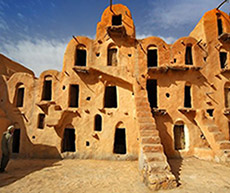 The Ksour region of southern Tunisia is remote, arid, craggy
and fascinating. In this parched terrain, harvests are rare,
and for centuries nomadic tribesmen have protected their
precious stores of grain and olives in communal ksour. The Ksour region of southern Tunisia is remote, arid, craggy
and fascinating. In this parched terrain, harvests are rare,
and for centuries nomadic tribesmen have protected their
precious stores of grain and olives in communal ksour.
Ksar Ouled Soltane doesn’t look like much from the outside –
a high-walled, windowless compound of tawny mud, next to a
hilltop mosque. But inside is a magnificent four-storey
fortified granary, with one of its two courtyards dating
from the 15th century – now a UNESCO site. A young guide
told us that members of his tribe still use the Ksar for
weekly prayers, community meetings and festivals. Each
barrel-vaulted storeroom, or ghorfa, is about eight feet
high and up to 30 feet deep; some still have ancient
palm-wood doors with hefty peg-and-hole locks. Inside, the
clay and gypsum walls are decorated with hand and
footprints, family names, holy eyes and fish, and messages
to Allah.
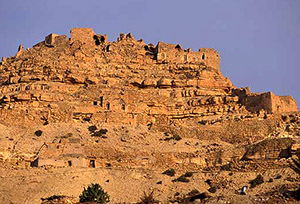 Ksar Hallouf is an even older granary, dating from the 13th
century. In one cool, dark ghorfa, a yellow-toothed
caretaker showed us a centuries-old oil press where, in his
father’s day, a donkey still pulled a circular boulder to
crush palm-frond bags of olives. In an even darker inner
cave, a giant palm trunk once pressed piles of palm-frond
filters, wedged between stones, and oil oozed into a clay
pit. Ksar Hallouf is an even older granary, dating from the 13th
century. In one cool, dark ghorfa, a yellow-toothed
caretaker showed us a centuries-old oil press where, in his
father’s day, a donkey still pulled a circular boulder to
crush palm-frond bags of olives. In an even darker inner
cave, a giant palm trunk once pressed piles of palm-frond
filters, wedged between stones, and oil oozed into a clay
pit.
Southern Tunisia’s steep escarpments are dotted with caves
where Berbers have lived since the 11th century, when Arabs
destroyed their lowland villages and farms. After a
delicious morning snack of ftair, a sweet fritter, we
visited Chenini, where 500 villagers still live in caves
burrowed into the craggy cliff face. A youth in a blue
turban and baggy trousers proposed himself as our guide.
Like many local boys, Nagi had spent several years selling
newspapers in Tunis, but now he had returned to look after
his grandmother, and, he explained, to help preserve
traditional customs and the Berber language which locals
still speak.
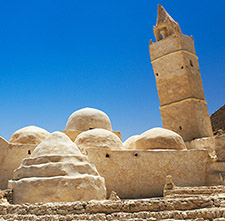
He took us first to the village cemetery, each rocky grave
marked with small standing stones – two for a man, and three
for a woman. Nearby, in a cave-mosque, lie the tombs of the
local marabout saint, and of the Seven Sleepers - imprisoned
Christians who miraculously grew to four meters tall, awoke
after four centuries, and died (again) as Muslim converts.
We followed Nagi up steep clay steps and along narrow paths
to Chenini’s cave-homes, which are constructed in tiers
following the geological strata of the cliff. We ducked
through a low archway to a small whitewashed courtyard,
where his 70-year-old grandmother sat at her loom. She was a
startling-looking crone with purple tattoos on nose and
chin, colourful clothes and clanking jewellery. Beyond her,
the family ghar had been burrowed into the hillside - cool
in summer and warm in winter. A separate cave served as a
kitchen, with an ancient electric fridge.
At lunchtime, Nagi obligingly yelled to someone far below,
and we stumbled down eight storeys of steep, earth steps,
through a series of caves, to a burrowed-out café with two
tables. As we ate chorba (spicy soup) and brik à l’oeuf (a
crispy pastry envelope containing a fried egg) Nagi tucked
into chicken and chips and asked if we had any Wayne Rooney
souvenirs.
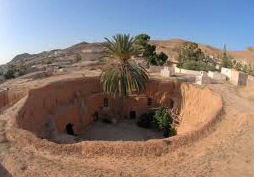 Driving northwest, we passed more troglodyte villages – some
abandoned, a scatter of dark holes in a pink craggy
hillside. Blank-walled granary fortresses stood alone,
impregnable in the stony desert. In the distance, a skyline
of sharp peaks loomed. A plump grey jerboa scuttled across
the road. Sheep and black goats grazed on dry scrub by a
long-dry oued, watched by a small child. As we gazed back
towards the glittering Mediterranean, a convoy of 4x4s
roared past, whisking holidaymakers from coastal resorts on
a ‘safari’. Driving northwest, we passed more troglodyte villages – some
abandoned, a scatter of dark holes in a pink craggy
hillside. Blank-walled granary fortresses stood alone,
impregnable in the stony desert. In the distance, a skyline
of sharp peaks loomed. A plump grey jerboa scuttled across
the road. Sheep and black goats grazed on dry scrub by a
long-dry oued, watched by a small child. As we gazed back
towards the glittering Mediterranean, a convoy of 4x4s
roared past, whisking holidaymakers from coastal resorts on
a ‘safari’.
The troglodyte settlement of Matmata bustles with tourists
and touts. Here 100 cave dwellings survive, some dating –
incredibly - from the 4th century BC. Each consists of a
large circular pit, 30 feet deep, reached by a rope ladder
or earth ramp, with tunnel-like underground rooms leading
off it. Many are now restaurants or hotels, and we had lunch
in one – chakchouka (chickpea stew topped with a fried egg).

As we drove west, the stony hamada desert gave way to the
erg – pale, ridged sand, scattered with grey-green tufts. To
the north rose the dramatic peaks of Jebel Tebaga. The road
was dead straight, and utterly empty. Discarded tyres were
piled at the roadside like postmodern art installations.
Mirages appeared and evaporated. A dust devil created a
whirlwind of sand. Camels stalked slowly across the
sand-strewn road – haughty, languid, heads held high.
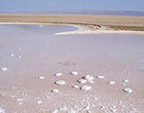 In Douz, palm frond fences attempt to hold back the Sahara,
and locals are wrapped in hooded cloaks against blown sand.
At the Musée du Sahara, a guide explained nomadic traditions
of swaddling bands, tattoos and the camel-hair burnouse.
Bedouin brides wear black embroidered robes, and ride a
camel pulled by a man who must be called Ali or Mohammed,
and accompanied by a child to ensure fertility. The bride is
concealed by a palanquin, with only her right hand showing -
the hand of Fatima. Strict rules once governed nomadic life
– a curtain in the tent separated men and visitors from
women and children, and the wife communicated with her
husband by banging a spoon on a wooden bowl, so that her
voice would not be heard. Our guide said that he now lives
in the town, but, like everyone he knows, he and his family
return to the desert every year, to spend several weeks in a
traditional Bedouin tent. In Douz, palm frond fences attempt to hold back the Sahara,
and locals are wrapped in hooded cloaks against blown sand.
At the Musée du Sahara, a guide explained nomadic traditions
of swaddling bands, tattoos and the camel-hair burnouse.
Bedouin brides wear black embroidered robes, and ride a
camel pulled by a man who must be called Ali or Mohammed,
and accompanied by a child to ensure fertility. The bride is
concealed by a palanquin, with only her right hand showing -
the hand of Fatima. Strict rules once governed nomadic life
– a curtain in the tent separated men and visitors from
women and children, and the wife communicated with her
husband by banging a spoon on a wooden bowl, so that her
voice would not be heard. Our guide said that he now lives
in the town, but, like everyone he knows, he and his family
return to the desert every year, to spend several weeks in a
traditional Bedouin tent.
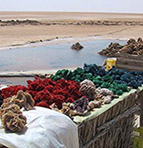 Passing Kebili, where black faces are a legacy of a
1000-year slave trade with Sudan, we reached the mesmerising
Chott el Jerid salt flats, a vast, blinding landscape,
dazzlingly white with glints of pink, purple, grey and blue.
In the middle of this glistening, silent moonscape, we
stopped at a shack selling wind-eroded quartz sandroses, and
drank sweet mint tea from grimy glasses. Passing Kebili, where black faces are a legacy of a
1000-year slave trade with Sudan, we reached the mesmerising
Chott el Jerid salt flats, a vast, blinding landscape,
dazzlingly white with glints of pink, purple, grey and blue.
In the middle of this glistening, silent moonscape, we
stopped at a shack selling wind-eroded quartz sandroses, and
drank sweet mint tea from grimy glasses.
 Beyond the salty chott, lies the oasis town of Tozeur, with
its matchless 14th-century medina – narrow alleys of
yellowish brick, doors decorated with studded nails, women
veiled in black with a blue stripe denoting their marital
status. The lush oasis has irrigation channels designed in
the 13th century. Here, under vibrant bougainvillea, on a
carpet of fallen pomegranates, we enjoyed plump, sweet
deglet annour ‘finger of light’ dates, from some of Tozeur’s
200,000 palms. Beyond the salty chott, lies the oasis town of Tozeur, with
its matchless 14th-century medina – narrow alleys of
yellowish brick, doors decorated with studded nails, women
veiled in black with a blue stripe denoting their marital
status. The lush oasis has irrigation channels designed in
the 13th century. Here, under vibrant bougainvillea, on a
carpet of fallen pomegranates, we enjoyed plump, sweet
deglet annour ‘finger of light’ dates, from some of Tozeur’s
200,000 palms.
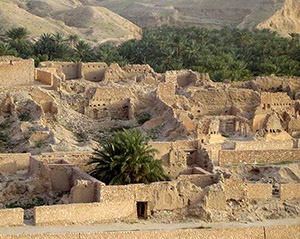 We drove on across another shimmering chott towards red
mountains with knife-edge peaks and corrugated ridges. The
remote oasis town of Tamerza is ringed by knobbly hills of
pale terracotta, with wind-gouged hollows and gunnels,
scrunched, crumpled, pleated and gathered. Almost on the
border with Algeria, the tiny village of Midès is
spectacularly perched on a precipitous outcrop, surrounded
by narrow crumbling canyons. As the sun set, each fold in
the mountain range turned a darker grey, and the strata in
the gorge below glowed red and gold. We drove on across another shimmering chott towards red
mountains with knife-edge peaks and corrugated ridges. The
remote oasis town of Tamerza is ringed by knobbly hills of
pale terracotta, with wind-gouged hollows and gunnels,
scrunched, crumpled, pleated and gathered. Almost on the
border with Algeria, the tiny village of Midès is
spectacularly perched on a precipitous outcrop, surrounded
by narrow crumbling canyons. As the sun set, each fold in
the mountain range turned a darker grey, and the strata in
the gorge below glowed red and gold.
As we headed back towards Djerba, we remembered arid hamada,
windswept erg, glistening chott and jebel peaks. We recalled
vaulted ghorfa in baked-mud ksour, and windowless ghar
dwellings. We pictured men in billowing jellabah or hooded
burnouse, and women in fluttering sifsari. We remembered
delicious meals of spicy chorba and chakchouka, crispy brik,
honeyed ftair and succulent deglet annour. And we felt
pleased to have learnt the Arabic words for the unfamiliar
and magical delights of southern Tunisia.
 THE INSIDE TRACK THE INSIDE TRACK
-
Go between the end of September and May, to avoid searing
summer heat.
-
Fly to Djerba and hire a car there for this road trip.
-
Roads in southern Tunisia are empty and well maintained,
with Tarmac surfaces. Sarah hired a regular car, but if you
want to drive further into the desert you will need a 4x4
vehicle.
-
Few in southern Tunisia speak English, so take a French or
Arabic phrase book.
WHAT TO BRING HOME
Delicious deglet annour dates, woven rugs, painted pottery,
brown quartz sandroses, and, from Douz, desert slippers (chaussures
sahariennes).
WHAT TO AVOID
-
Organized ‘desert safaris’ sally forth from coastal hotels
in convoys of 4x4s. As they roar past, you’ll feel very glad
not to be on one.
-
In Matmata, say “No” to the touts who vie with each other to
escort you to the cave where Star Wars was filmed, or to the
museum, charging exorbitant prices. The Star Wars hotel is
called Sidi Driss (entry free); the small cave museum is
interesting and is easy to find. Entry costs about £1.50,
and the tout-guides are not allowed in.
-
To avoid running out of petrol, make sure you fill up the
tank whenever you see a petrol station. In remote villages,
ask locals and a young lad will appear with a plastic
container of petrol.


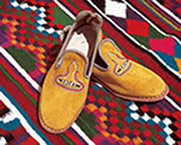
First published by the Telegraph
©SarahShuckburgh
|